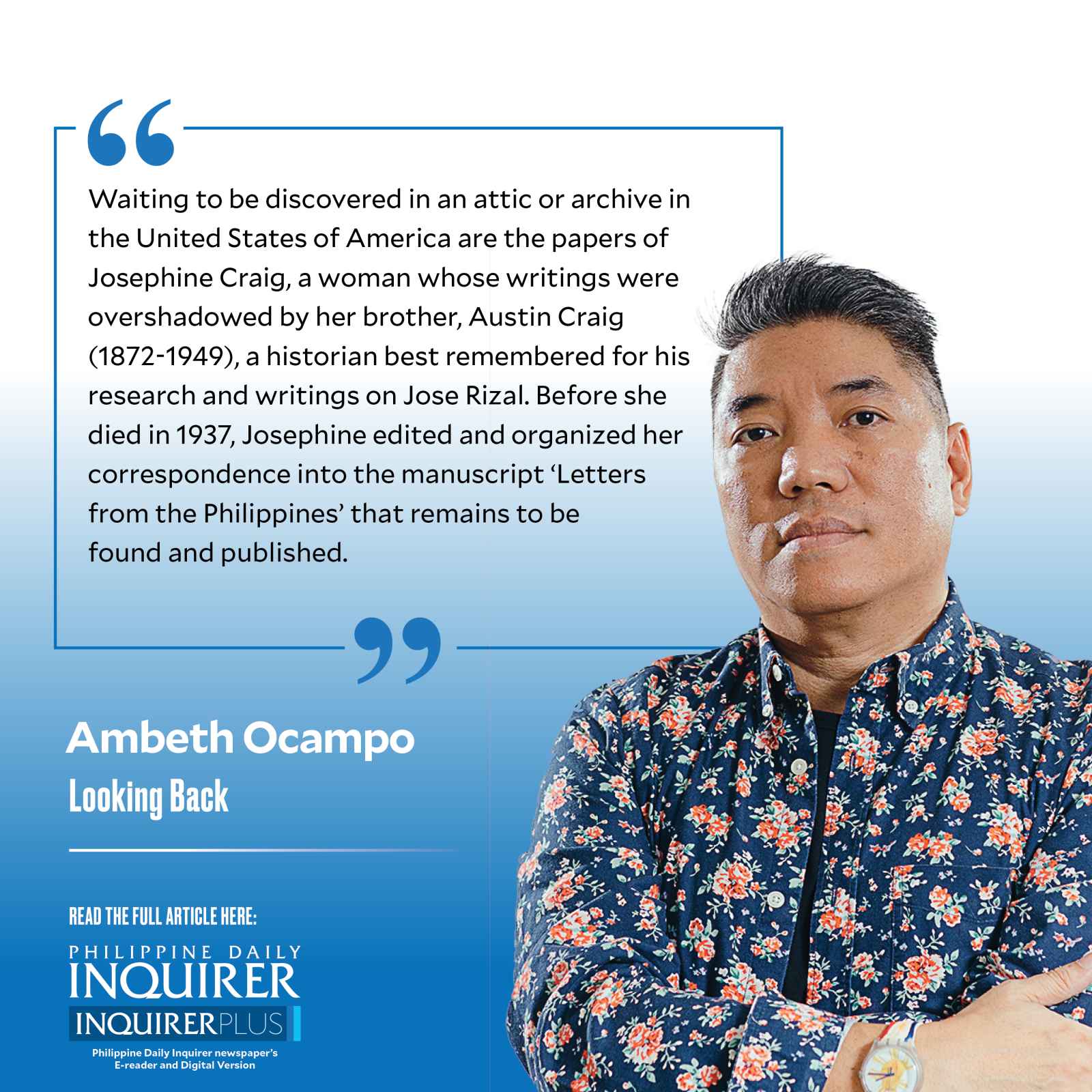
In their home in Calapan, Mindoro, they had “a perfectly good snake of the python variety living in our roof! The ceiling of the living-room is ‘sawali’ … Evenings I hear a slithering sound overhead and the sawali bulges down under the weight of the snake’s body; then there is squealing of rats, as he pounces, and all grows quiet again while the snake digests his meal. [She asked her brother] if there were any danger of his coming down to make our acquaintance, but he thinks not so long as the supply of rats remains plentiful.”
Waiting to be discovered in an attic or archive in the United States of America are the papers of Josephine Craig, a woman whose writings were overshadowed by her brother, Austin Craig (1872-1949), a historian best remembered for his research and writings on Jose Rizal. Before she died in 1937, Josephine edited and organized her correspondence into the manuscript “Letters from the Philippines” that remains to be found and published. Another unpublished manuscript of hers, “Thrice Travelled Trail,” covers her three visits to the Philippines. We know of Josephine’s writings from snippets in the book “Farthest Westing: A Philippine Footnote” (1940) published under the joint byline of Josephine and Austin Craig.The title of the book refers to the Philippines as the farthest US colony and covers the years 1904-1935 and of these 21 years, Josephine only appears in four sections of the book providing us a vivid glimpse of what she saw and experienced, the rest of the book details the research of Austin Craig. The Craigs seem to have settled into the Philippines quite easily, and stayed a long time unlike others who arrived on the same boat. Josephine seemed happy in her first residence, in Calapan, Mindoro. She later moved to Manila, living first in a nipa hut, and later a bahay-na-bato.She noted that Secretary of the Interior Dean C. Worcester was “apparently the most disliked of the American [colonial] officials.” Worcester was the subject of a scathing editorial, “Aves de Rapiña” (Birds of Prey) by Fidel Reyes that appeared in the Filipino nationalist newspaper El Renacimiento. Worcester sued for libel in 1909 and won. Not content with a criminal case (libel) Worcester also filed a civil suit. Josephine added that “the most ridiculed” member of the Philippine Commission was William Cameron Forbes, for whom Forbes Park and the former Forbes Avenue in Manila were named:
“He is the grandson of Ralph Waldo Emerson and related to the Boston merchant prince who made a name in Oriental trading … he is a multimillionaire … he has brought a small army of Back Bay relatives, all from Harvard, who work with him without cost to the government. He and his crowd, I have been told, are not snobbish and remarkably efficient.”Josephine taught music using a phonograph. She made the students listen to music, then she focused on the lyrics, setting the replay speed from slow to fast as the students caught on. She was very creative in the classroom and noted that everyone in Calapan was Catholic, “even the forty Masons.” As a matter of fact, her brother Austin wondered why Secretary Worcester “classified Mindoro as a non-Christian province, although the Christians far outnumber the heathens.” Josephine sent for a hundred rosaries and a hundred printed Catholic catechism and rewarded the students who learned the catechism in English with a rosary. In time, grandmothers asked their grandchildren to teach them the catechism that they only knew by rote and didn’t truly understand.
On a short visit to Manila, Josephine saw Gregorio Aglipay in Luneta describing “his face and head of such distinction and character.” She also compiled a “list of odors—not to use the good old English word ‘stenches’—to be avoided.” One entry was copra out for drying! Another was the smell of a ship’s cabin whose bedsheets had blood stains from bed bugs. She complained about clothes washed by “Pinay lavanderas” that returned “with an unspeakable odor.” Other smells that were new to her were that of carabao and bird dung, in addition, that of a church full of parishioners! When I have time, I will go over the book again and extract all the odors listed by Josephine as I’m sure there is a pattern here that might lead to insight into the Filipino smell.
Upon arrival, the Craigs called on the governor of Calapan carrying pasalubong of condensed milk at which Josephine remarked:
“Apropos of canned milk, there is a Swiss variety used here called Bear Brand Milk [that used to be known in Spanish as ‘Marca Oso’] which has a picture of a bear on its label. The Filipino food inspectors of the port of Manila joked about its importation, claiming it was falsely labelled bear’s milk when, in reality, it was cow’s milk.”
Josephine’s letters form a small group of primary sources on the early 20th-century Philippines by women that provide another viewpoint: Her-story rather than His-tory.
—————–
Comments are welcome at aocampo@ateneo.edu